climate control MERCEDES-BENZ C CLASS COUPE 2002 Owner's Manual
[x] Cancel search | Manufacturer: MERCEDES-BENZ, Model Year: 2002, Model line: C CLASS COUPE, Model: MERCEDES-BENZ C CLASS COUPE 2002Pages: 399, PDF Size: 16.59 MB
Page 172 of 399
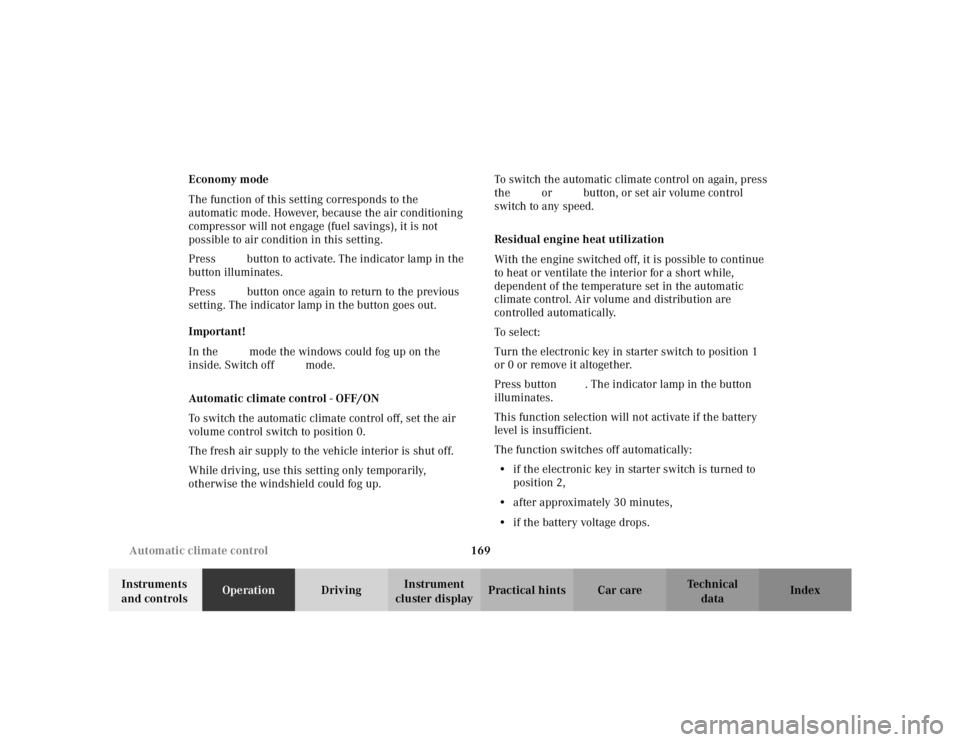
169
Automatic climate control
Te ch n i c a l
data
Instruments
and controls Operation
DrivingInstrument
cluster display Practical hints Car care Index
Economy mode
The function of this setting corresponds to the
automatic mode. However, because the air conditioning
compressor will not engage (fuel savings), it is not
possible to air condition in this setting.
Press
S button to activate. The indicator lamp in the
button illuminates.
Press S button once again to return to the previous
setting. The indicator lamp in the button goes out.
Important!
In the S mode the windows could fog up on the
inside. Switch off S mode.
Automatic climate control - OFF/ON
To switch the automatic climate control off, set the air
volume control switch to position 0.
The fresh air supply to the vehicle interior is shut off.
While driving, use this setting only temporarily,
otherwise the windshield could fog up. To switch the automatic climate control on again, press
the
U or P button, or set air volume control
switch to any speed.
Residual engine heat utilization
With the engine switched off, it is possible to continue
to heat or ventilate the interior for a short while,
dependent of the temperature set in the automatic
climate control. Air volume and distribution are
controlled automatically.
To s e l e c t :
Turn the electronic key in starter switch to position 1
or 0 or remove it altogether.
Press button T. The indicator lamp in the button
illuminates.
This function selection will not activate if the battery
level is insufficient.
The function switches off automatically:
• if the electronic key in starter switch is turned to
position 2,
• after approximately 30 minutes,
• if the battery voltage drops.
Page 173 of 399
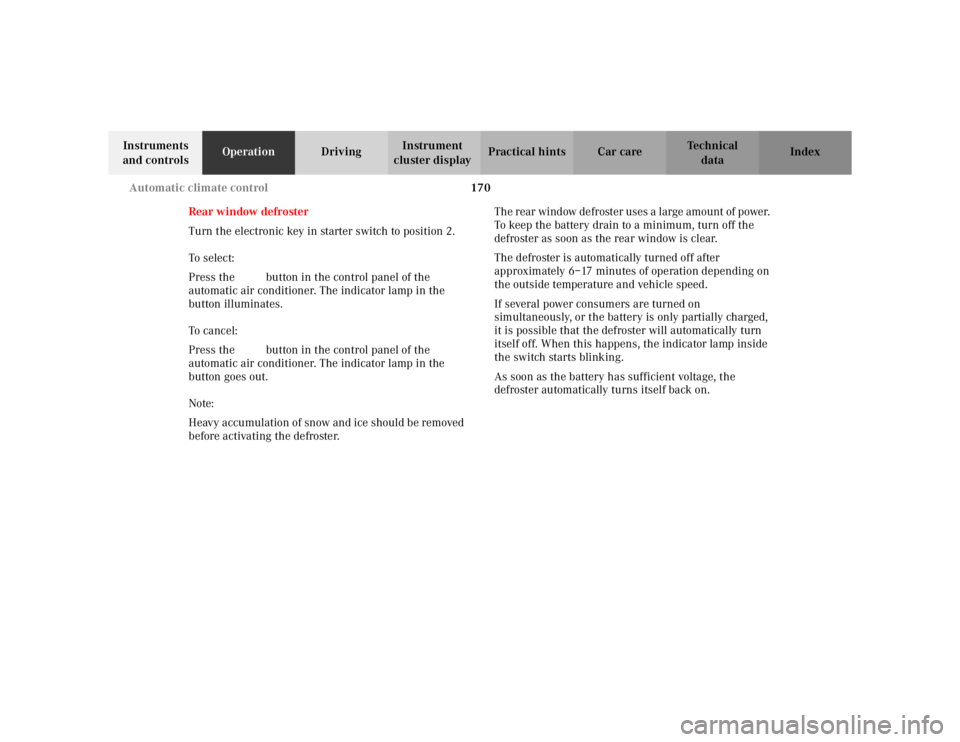
170
Automatic climate control
Te ch n i c a l
data
Instruments
and controls Operation
DrivingInstrument
cluster display Practical hints Car care Index
Rear window defroster
Turn the electronic key in starter switch to position 2.
To select:
Press the F button in the control panel of the
automatic air conditioner. The indicator lamp in the
button illuminates.
To c a nc el:
Press the F button in the control panel of the
automatic air conditioner. The indicator lamp in the
button goes out.
Note:
Heavy accumulation of snow and ice should be removed
before activating the defroster. The rear window defroster uses a large amount of power.
To keep the battery drain to a minimum, turn off the
defroster as soon as the rear window is clear.
The defroster is automatically turned off after
approximately 6–17 minutes of operation depending on
the outside temperature and vehicle speed.
If several power consumers are turned on
simultaneously, or the battery is only partially charged,
it is possible that the defroster will automatically turn
itself off. When this happens, the indicator lamp inside
the switch starts blinking.
As soon as the battery has sufficient voltage, the
defroster automatically turns itself back on.
Page 174 of 399
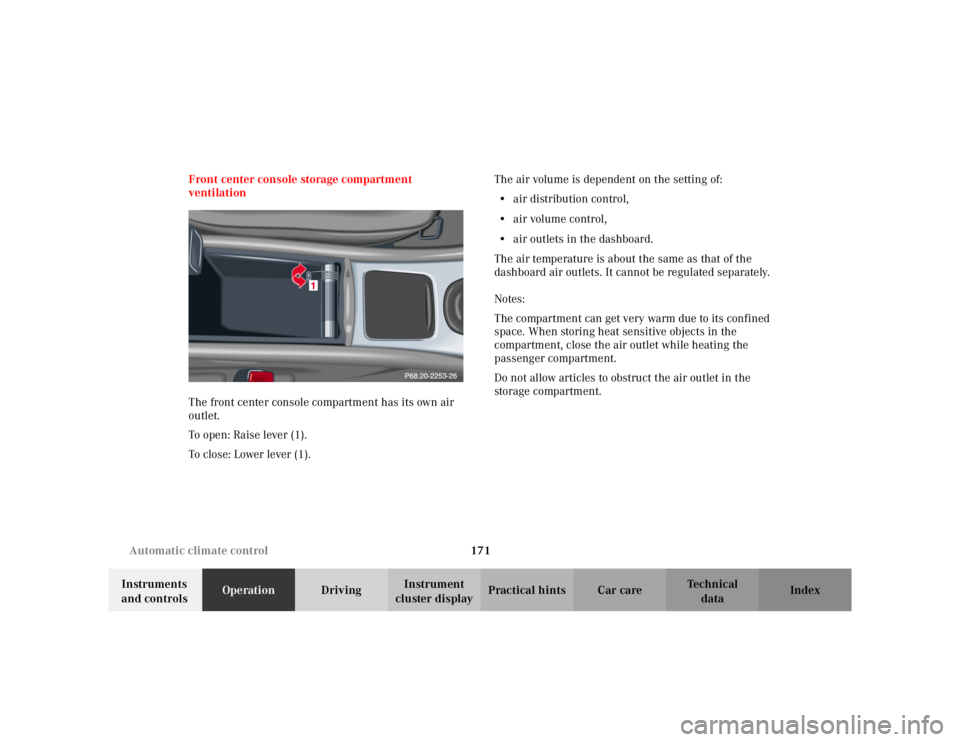
171
Automatic climate control
Te ch n i c a l
data
Instruments
and controls Operation
DrivingInstrument
cluster display Practical hints Car care Index
Front center console storage compartment
ventilation
The front center console compartment has its own air
outlet.
To open: Raise lever (1).
To close: Lower lever (1).
The air volume is dependent on the setting of:
• air distribution control,
• air volume control,
• air outlets in the dashboard.
The air temperature is about the same as that of the
dashboard air outlets. It cannot be regulated separately.
Notes:
The compartment can get very warm due to its confined
space. When storing heat sensitive objects in the
compartment, close the air outlet while heating the
passenger compartment.
Do not allow articles to obstruct the air outlet in the
storage compartment.
Page 175 of 399
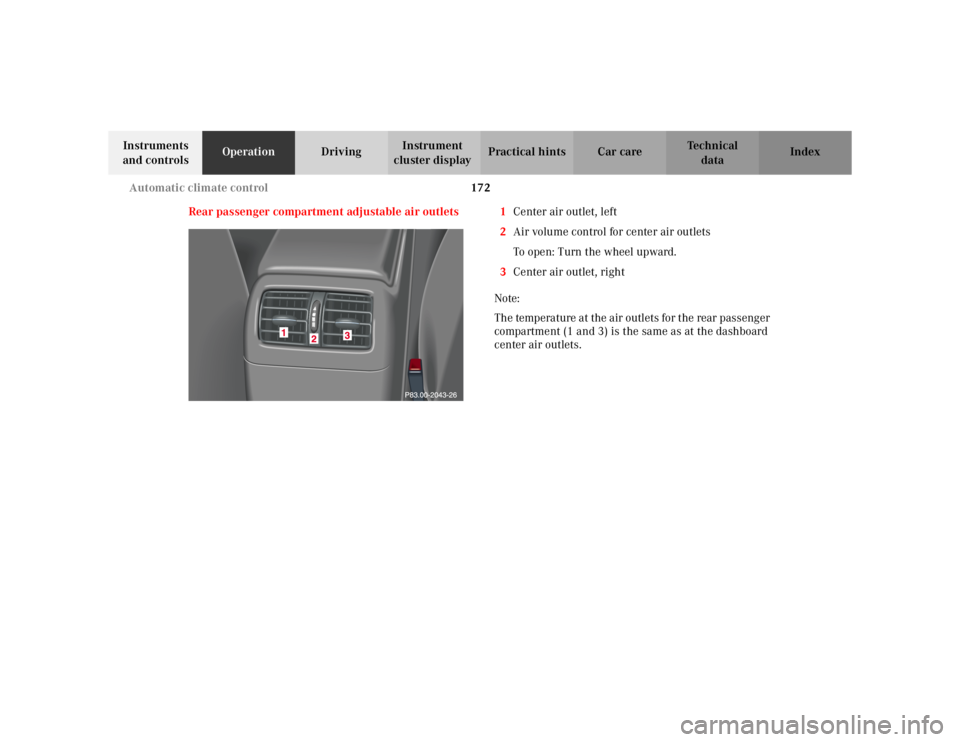
172
Automatic climate control
Te ch n i c a l
data
Instruments
and controls Operation
DrivingInstrument
cluster display Practical hints Car care Index
Rear passenger compartment adjustable air outlets 1 Center air outlet, left
2 Air volume control for center air outlets
To open: Turn the wheel upward.
3 Center air outlet, right
Note:
The temperature at the air outlets for the rear passenger
compartment (1 and 3) is the same as at the dashboard
center air outlets.
Page 201 of 399
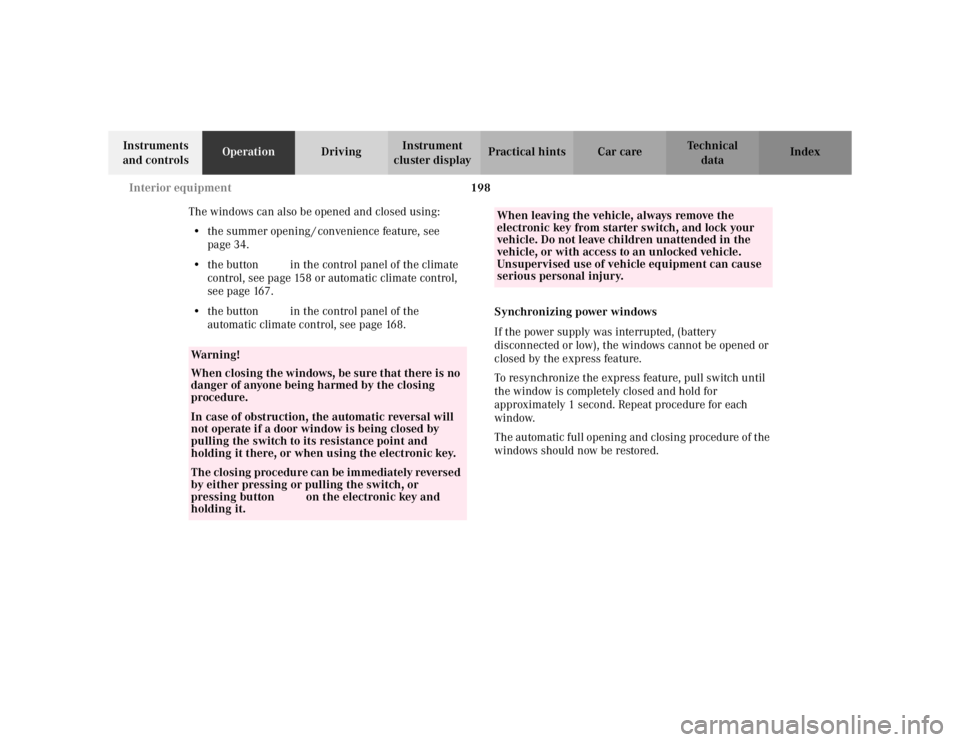
198
Interior equipment
Te ch n i c a l
data
Instruments
and controls Operation
DrivingInstrument
cluster display Practical hints Car care Index
The windows can also be opened and closed using: • the summer opening / convenience feature, see
page 34.
• the button O in the control panel of the climate
control, see page 158 or automatic climate control,
see page 167.
• the button e in the control panel of the
automatic climate control, see page 168. Synchronizing power windows
If the power supply was interrupted, (battery
disconnected or low), the windows cannot be opened or
closed by the express feature.
To resynchronize the express feature, pull switch until
the window is completely closed and hold for
approximately 1 second. Repeat procedure for each
window.
The automatic full opening and closing procedure of the
windows should now be restored.
Wa r n i n g !
When closing the windows, be sure that there is no
danger of anyone being harmed by the closing
procedure.In case of obstruction, the automatic reversal will
not operate if a door window is being closed by
pulling the switch to its resistance point and
holding it there, or when using the electronic key.The closing procedure can be immediately reversed
by either pressing or pulling the switch, or
pressing button
Œon the electronic key and
holding it.
When leaving the vehicle, always remove the
electronic key from starter switch, and lock your
vehicle. Do not leave children unattended in the
vehicle, or with access to an unlocked vehicle.
Unsupervised use of vehicle equipment can cause
serious personal injury.
Page 244 of 399

241
Starter switch
Te ch n i c a l
data
Instruments
and controls Operation
DrivingInstrument
cluster display Practical hints Car care Index
Important!
If the electronic key is left in the starter switch
position 0 for a extended period of time, it can no longer
be turned in the lock. In this case, remove electronic key
from starter switch and reinsert.
Caution!
To prevent accelerated battery discharge and a possible
dead battery, always remove the electronic key from the
starter switch.
Do not leave the electronic key in starter
switch position 0. Notes:
A warning sounds when the driver’s door is opened
with the electronic key is in starter switch position 1
or 0.
If the electronic key cannot be turned in the starter
switch, the vehicle battery may not be sufficiently
charged. See battery on page 336 or jump starting on
page 338.
With the engine at idle speed, the charging rate of the
alternator (output) is limited.
It is therefore recommended that you turn off
unnecessary electrical consumers while driving in stop-
and-go traffic. This precaution helps to avoid draining of
the battery.
Unnecessary strain on the battery and charging system
may be minimized by turning off the following power
consumers, for example:
Heated seats, rear window defroster. In addition, the
automatic climate air volume control should be set to
the lowest position.
Page 364 of 399

361
Cleaning and care of the vehicle
Te ch n i c a l
data
Instruments
and controls Operation Driving
Instrument
cluster display Practical hints
Car care Index
Scratches, corrosive deposits, corrosion or damage due
to negligent or incorrect care cannot always be removed
or repaired with the car-care products recommended
here. In such cases it is best to seek aid at your
authorized Mercedes-Benz Center.
The following topics deal with the cleaning and care of
your vehicle and give important “how-to” information as
well as references to Mercedes-Benz approved car-care
products.
Additional information can be found in the booklet titled
“Vehicle Care Guide”.
Power washer
When using a power washer for cleaning the vehicle
always observe manufacturer’s operating instructions.
Caution!
Never use a round nozzle to power wash tires. The
intense jet of water can result in damage to the tire.
Always replace a damaged tire.
Always keep the jet of water moving across the surface.
Do not aim directly at electrical parts, electrical
connectors, seals, or other rubber parts.
Tar stains
Quickly remove tar stains before they dry and become
more difficult to remove. A tar remover is
recommended.
Paintwork, painted body components
Mercedes-Benz approved Paint Care should be applied
when water drops on the paint surface do not “bead up”,
normally in 3 to 5 months, depending on climate and
washing detergent used.
Mercedes-Benz approved Paint Cleaner should be
applied if paint surface shows signs of dirt embedding
(i.e. loss of gloss).
Do not apply any of these products or wax if your
vehicle is parked in the sun or if the hood is still hot.
Use the appropriate MB-Touch-Up Stick for quick and
provisional repairs of minor paint damage (i.e. chips
from stones, vehicle doors etc.).
Page 386 of 399

383
Consumer information
Te ch n i c a l
data
Instruments
and controls Operation Driving
Instrument
cluster display Practical hints Car care Index
Consumer information
This has been prepared as required of all manufactures
of passenger cars under Title 49, Code of U.S. Federal
Regulations, Part 575 pursuant to the “National Traffic
and Motor Vehicle Safety Act of 1966”.
Uniform tire quality grading
Quality grades can be found where applicable on the
tire sidewall between tread shoulder and maximum
section width. For example:
All passenger car tires must conform to federal safety
requirements in addition to these grades.
Treadwear
The treadwear grade is a comparative rating based on
the wear rate of the tire when tested under controlled
conditions on a specified government test course. For
example, a tire graded 150 would wear one and one-half
(1
1/2) times as well on the government course as a tire
graded 100. The relative performance of tires depends
upon the actual conditions of their use, however, and may depart significantly from the norm due to
variations in driving habits, service practices and
differences in road characteristics and climate.
Traction
The traction grades, from highest to lowest are AA, A, B,
and C. Those grades represent the tire’s ability to stop
on wet pavement as measured under controlled
conditions on specified government test surfaces of
asphalt and concrete. A tire marked C may have poor
traction performance.
Tread wear 200 Traction AA Temperature A
Wa r n i n g !
The traction grade assigned to this tire is based on
straightahead braking traction tests, and does not
include acceleration, cornering, hydroplaning, or
peak traction characteristics.
Page 388 of 399

385
Index
Te ch n i c a l
data
Instruments
and controls Operation Driving
Instrument
cluster display Practical hints Car care
Index
Index
AAdding engine oil........................................................... 318
Air pump ......................................................................... 322
Airbags .............................................................................. 72
ANTILOCK BRAKE SYSTEM
Malfunction and warning message........................ 293
Antilock brake system (ABS) ....................................... 272
Antitheft alarm system ................................................... 44
Ashtrays........................................................................... 211
Audio system Button and soft key operation................................. 176
Cassette mode ........................................................... 182
CD changer ................................................................ 187
CD mode ..................................................................... 186
Operating and display elements............................. 174
Operating safety ........................................................ 173
Operation.................................................................... 176
Operation Audio and telephone .............................. 173
Radio mode ................................................................ 179
Telephone operation ................................................. 190 Audio systems................................................................. 108
Cassette player .......................................................... 110
CD Player .................................................................... 109
Radio ........................................................................... 108
Automatic central locking .............................................. 40
Automatic climate control ............................................ 160 Activated charcoal filter ........................................... 168
Adjustable air outlets, rear passenger compartment ......................................................... 172
Air recirculation ........................................................ 167
Air volume, manual .................................................. 165
Basic setting............................................................... 164
Defrosting ................................................................... 166
Display and controls ................................................. 162
Dust filter.................................................................... 164
Economy mode .......................................................... 169
Front center console storage compartment ventilation..................................... 171
Residual engine heat utilization ............................. 169
Special settings ......................................................... 165
Windows fogged up on the outside ........................ 166
Automatic transmission ............................................... 246 Fluid level ................................................................... 317
Transmission selector lever, manually unlocking ............................................ 344
Page 389 of 399
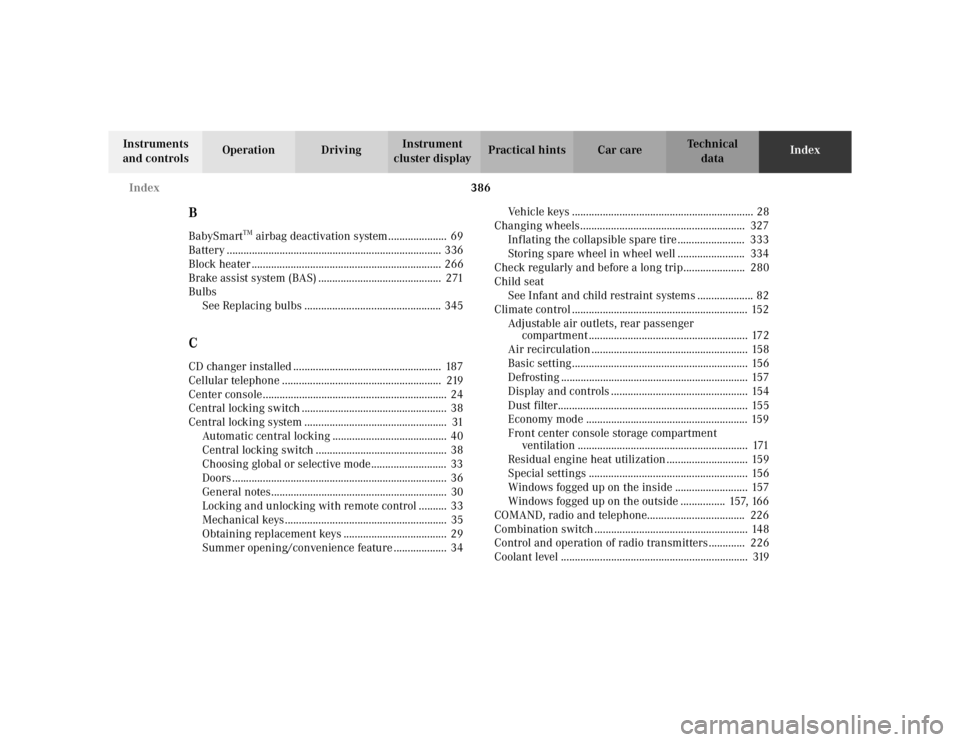
386
Index
Te ch n i c a l
data
Instruments
and controls Operation Driving
Instrument
cluster display Practical hints Car care
Index
BBabySmart
TM airbag deactivation system..................... 69
Battery ............................................................................. 336
Block heater .................................................................... 266
Brake assist system (BAS) ............................................ 271
Bulbs See Replacing bulbs ................................................. 345
CCD changer installed ..................................................... 187
Cellular telephone ......................................................... 219
Center console .................................................................. 24
Central locking switch .................................................... 38
Central locking system ................................................... 31Automatic central locking ......................................... 40
Central locking switch ............................................... 38
Choosing global or selective mode........................... 33
Doors ............................................................................. 36
General notes............................................................... 30
Locking and unlocking with remote control .......... 33
Mechanical keys .......................................................... 35
Obtaining replacement keys ..................................... 29
Summer opening/convenience feature ................... 34 Vehicle keys ................................................................. 28
Changing wheels........................................................... 327 Inflating the collapsible spare tire ........................ 333
Storing spare wheel in wheel well ........................ 334
Check regularly and before a long trip...................... 280
Child seat See Infant and child restraint systems .................... 82
Climate control ............................................................... 152 Adjustable air outlets, rear passenger compartment ......................................................... 172
Air recirculation ........................................................ 158
Basic setting............................................................... 156
Defrosting ................................................................... 157
Display and controls ................................................. 154
Dust filter.................................................................... 155
Economy mode .......................................................... 159
Front center console storage compartment ventilation ............................................................. 171
Residual engine heat utilization ............................. 159
Special settings ......................................................... 156
Windows fogged up on the inside .......................... 157
Windows fogged up on the outside ................ 157, 166
COMAND, radio and telephone................................... 226
Combination switch ....................................................... 148
Control and operation of radio transmitters ............. 226
Coolant level ................................................................... 319